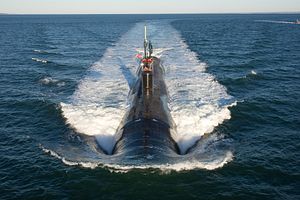The U.S. Navy will for the first time deploy Unmanned Underwater Vehicles (UUVs) from Virginia-class attack submarines by the end of this year reports military.com.
According to the U.S. Navy’s director for undersea warfare, Rear Admiral Joseph Tofalo, the soon-to-be deployed underwater drones will be commercially available UUVs such as the REMUS 600 Autonomous Underwater Vehicle.
Designed through funding from the Office of Naval Research, the REMUS 600 is modeled after the REMUS 100 UUV, built by the Norwegian-based Kongsberg Maritime defense contractor, and can be deployed for a wide range of missions including mine counter measure, harbor security, and search and salvage operations.
The UUV is constructed by the Kongsberg U.S.-based subsidiary, Hydroid, and is similar to the Bluefin-21 UUV, which was used for the search of Malaysia Airlines Flight 370 in 2014, military.com notes. The U.S. Navy plans to expand its use of existing commercial off-the-shelf technology as Tofalo explains:
We’re using commercial off-the-shelf technologies to do real world missions for the combatant commander. The oil and gas industry uses these things for all kinds of functions. The submarine force will be adapting this. The sensors are similar to the sensors that the oil and gas industry might use. They might be surveying where their oil pipes are, whereas we might want to be looking for a mine field.
The Remus 600 UUVs will be launched from a dry deck shelter – a removable module that can be attached to a submarine – which makes entering and exiting a sub easier when the boat is submerged.
Other UUVs could also soon be launched through the Virginia Payload Module tube, Tofalo notes:
For the large diameter UUV itself, what we want to have is an interface that allows it to come out of that Virginia Payload Module tube. To do that we need an arm that can extend itself with a little platform that can extend itself and go to the vertical.
The U.S. Navy is currently testing and developing a host of different underwater drones and has allocated a “significant” amount of money for the expansion of its UUV fleet in the Pentagon’s 2016 budget request.
For example, the Naval Research Laboratory is testing a drone (“The Flimmer”) that can operate both in the air and underwater and can attack enemy submarines. The Upward Falling Payload program run by the Defense Advanced Research Projects Agency (DARPA) and experimenting with launching aerial drones from ocean floors is another example.
The Office of Naval Research will also unveil a new autonomous UUV prototype called the Large Displacement Unmanned Undersea Vehicle (LDUUV) military.com reports. A prototype is supposed to be ready by 2017. The article further notes that the U.S. Navy is also testing a small submarine-launched UAV called the Switchblade, capable of carrying up to three pounds of explosives. Additionally, Wired reported on a new underwater reconnaissance drone called the “Ghost Swimmer”, which is designed to look and swims like a fish.
It is noteworthy, however, that UUV technology is not maturing as quickly as UAVs, first and foremost because it is a lot more difficult to communicate with UUVs than aerial drones – oceans are opaque to radio signals and acoustic signals travel a lot slower than radio waves. Consequently, UUVs have to be almost completely autonomous.
According to Frank Herr, head of the Office of Naval Research’s ocean battlespace sensing department: “Underwater vehicles are much harder to do because of this inability for us to communicate robustly with the vehicles the way you can in the air. That means they are way behind in the development.”
Nevertheless, UUVs will certainly be a game changer in the years to come as Tofalo notes:
Now you are talking about a submarine CO who can essentially be in two places at the same time – with a UUV out deployed which can do dull, dirty and dangerous type missions. This allows the submarine to be doing something else at the same time.UUVs can help us better meet our combatant command demand signal. Right now, we only meet about two-thirds of our combatant commanders demand signals and having unmanned systems is a huge force multiplier.
Indeed, a recent report by the influential Center for Strategic and Budgetary Assessments (CSBA) called for the development of a new family of (unmanned) undersea vehicles (see: “The End of The Submarine as We Know It?”)
As I wrote before, the CSBA report emphasizes that we need to rethink some of the fundamental underpinnings of undersea warfare and, for example, comes to terms that “manned submarines will likely need to shift from being frontline tactical platforms like aircraft to being host and coordination platforms like aircraft carriers.” This would be a big change from how large portions of the U.S. submarine fleet are used today.
The aircraft carrier comparison would also imply that future submarines would need to be bigger than today’s Virginia-class submarines, in order to accommodate a host of new systems, as well as an array of unmanned vehicles and weapons.

































